The sophisticated taste of Japan
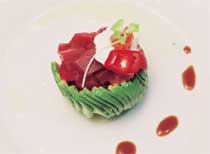
Tuna with avocado |
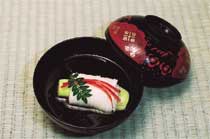
Noodle soup with roasted eggplant |
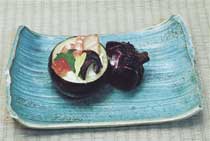
Kamo-nasu eggplant combination |
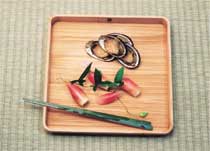
Tokobushi (kind of abalone) with mini-sushi decoration in a form of morning glory buds. |
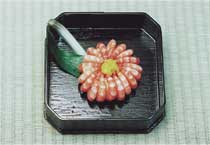
Shrimp sushi |
Food of a country is part of culture of the country, as it takes centuries to find out the best possible ways to prepare dishes. It reflects what has been available in that country for food and what kinds of life style people have been leading.
In this respect, Japanese cooking has been developed to enhance the taste of rice, which is the building ground of Japanese cooking. There are many Japanese dishes highly regarded for its great matching with cooked rice.
One should note that Japanese are lucky to be surrounded by oceans that provide fresh sea food, to be in a semi-tropical climate that provides plenty of tasty vegetables. As Japanese food materials are very tasty as they are, cooking style has been to enhance the goodness of original flavor, rather than modify it with all sorts of seasonings to make it fit to eat. This resulted Japanese dishes to be rather plain simple taste. Those who are accustomed to spicy and/or butter- and cream-rich food may find it too bland, until they get out of the habit to eating spicy flavorful food. Then, they will understand and start appreciating the way of life in Japan, in addition to the taste of Japan itself. Another distinctive feature of Japanese dishes is that chefs make a big effort to select a plate for each dish to make the visual presentation more appealing. They collect lots of plates, cups, bowls and so forth in all sorts of colors and design to achieve this. Japanese chefs have to have an artistic talent.
Being a chef is somewhat like a singer before recording technology was invented. A good singer can bring down the house with his/her great performance, but nothing except for the fame remains after the concert. A chef may produce great dishes, but there won’t be any of his/her art left after the dining, except for appreciation for the great taste. A chef can produce fantastic taste or awful taste using the same materials or recipe. A little bit of something really makes a big difference in taste. Hence it is an art, a volatile art. Here, it is more difficult to keep the tradition, as one can not leave the physical something for successors to learn from.
Mr. Kozo SATOH has been a chef for 40 years. He serves Kaiseki Ryori, a classic Japanese full course dinner, in his own small restaurant in Tokyo. He is very serious as a professional chef. He would refuse a customer if the customer turned out to be incapable of distinguishing a good food from a junk food. However, he is a delightful person to be with once you are admitted in.
Mr. Satoh is not a copycat of past culinary tradition of Japan. In fact, he is extremely creative and liberally use foreign food materials and spices that interest him. Under his orchestration, great taste suddenly emerges like a magic. However, his dishes are the traditional Japanese dishes in its spirit and that fundamental baseline is to enhance the taste of rice and sake, the Japanese
rice wine.
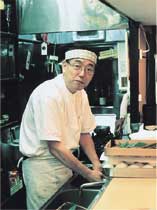
He has been a great teacher to bring up his successors, telling all of his secrets to his students. His former students are working at various places, including Toronto in Canada. Three years ago, he was asked to do a cooking demonstration at a cooking school in Perigueux in France when he was a tourist to the town and his dishes were so much praised, the Mayor named him to be an honorary citizen of Perigueux and presented him the honor to be the Knight of Pâté de foie gras. He demonstrates Japanese cooking by requests as far as in Athen, Paris and St. Benedetto in Italy. He teaches cooking (and all sorts of other things as well) as he feels it is important to keep the cooking culture alive and being inherited by the next generations. This way, the culture will be kept alive beyond his life span even if diners would not leave a smudge of food for future references. (TKO)
